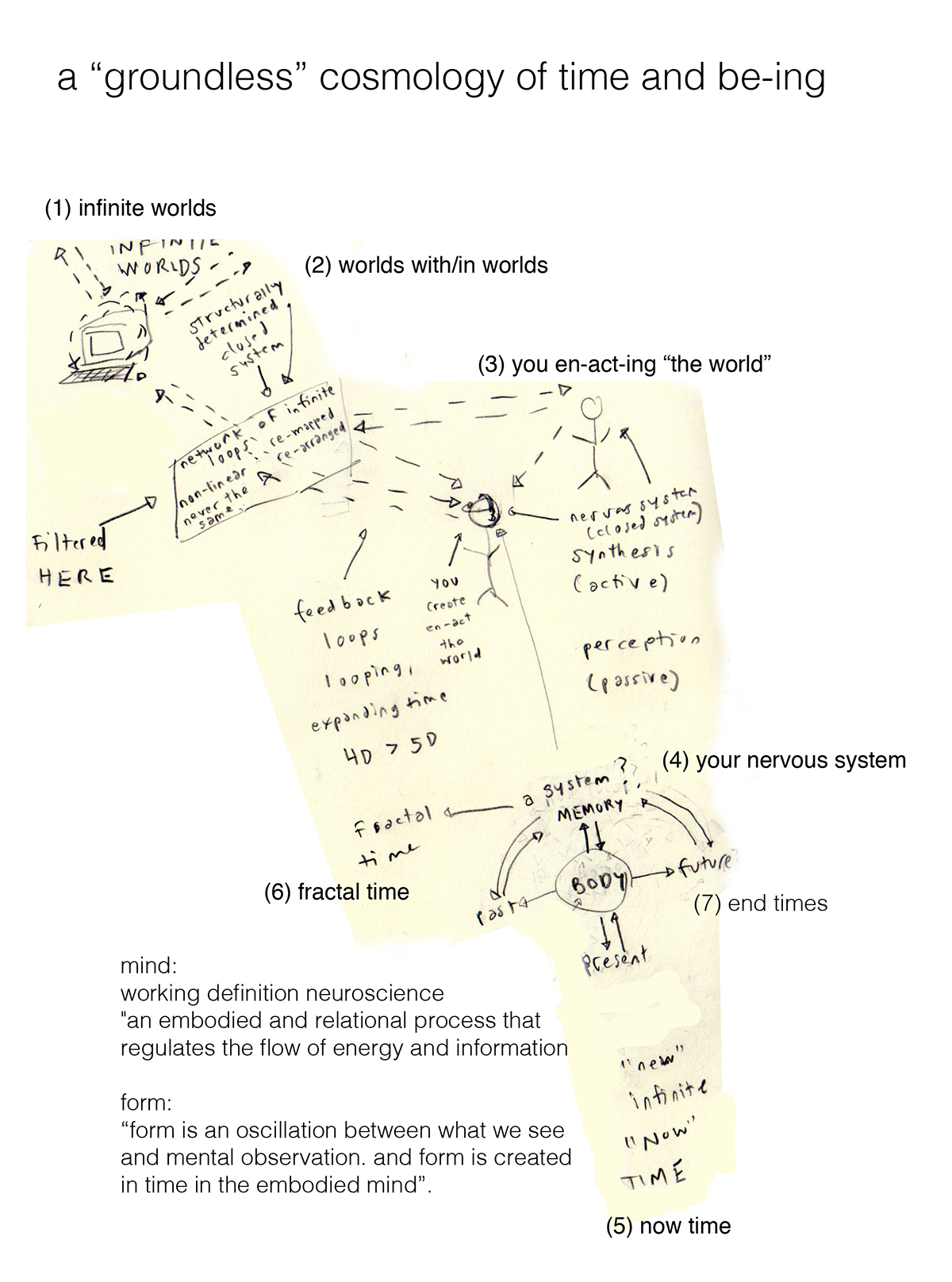Anti-Apocalypse sets the stage for the collapse of the subject/self by exploiting the visual perceptual system used to re-/construct identity and reality through the accumulation, assimilation, and recollection of images within the dominant framework of time. The project combines digital video, electroencephalograph (EEG) biofeedback, and custom software to create an immersive cinematic experience that can be altered by the viewer’s fluctuating brainwave activity. As participants watch the interactive video unfold in synchronization with their level of in-/attention, they are invited to reflect on contemporary events in an accelerating global crisis; narratives rooted in moral absolutism and collective annihilation; and the underlying forces embodied within the processes through which we co-author our realities. The real-time, interactive experience also prompts questions about the nature of individual autonomy and the increasingly entangled relationships between self and image, self and machine, self and the deterritorializing/reterritorializing forces that re-/produce the self, self and all past events leading up to and shaping the present-future moment.
Anti-Apocalypse
Installation, HD video, custom software, electro-encephalograph (EEG) brain-computer interface
2012
OVERVIEW
Anti-Apocalypse explores how the embodiment of memory in networked media influences how we re-/co-/create our worlds and our selves.
The project combines digital video, electroencephalograph (EEG) biofeedback, and custom software to create an immersive cinematic experience that can be altered by the viewer’s fluctuating brainwave activity.
As participants watch the interactive video unfold in synchronization with their level of in-/attention, they are invited to reflect on contemporary events in an accelerating global crisis; narratives rooted in moral absolutism and collective annihilation; and the underlying forces embodied within the processes through which we co-author our realities.
DOCUMENTATION
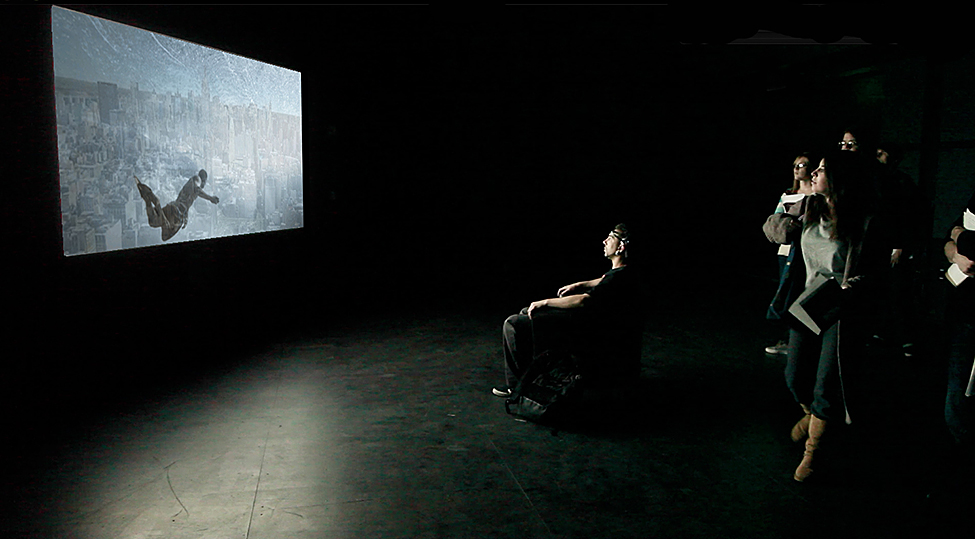
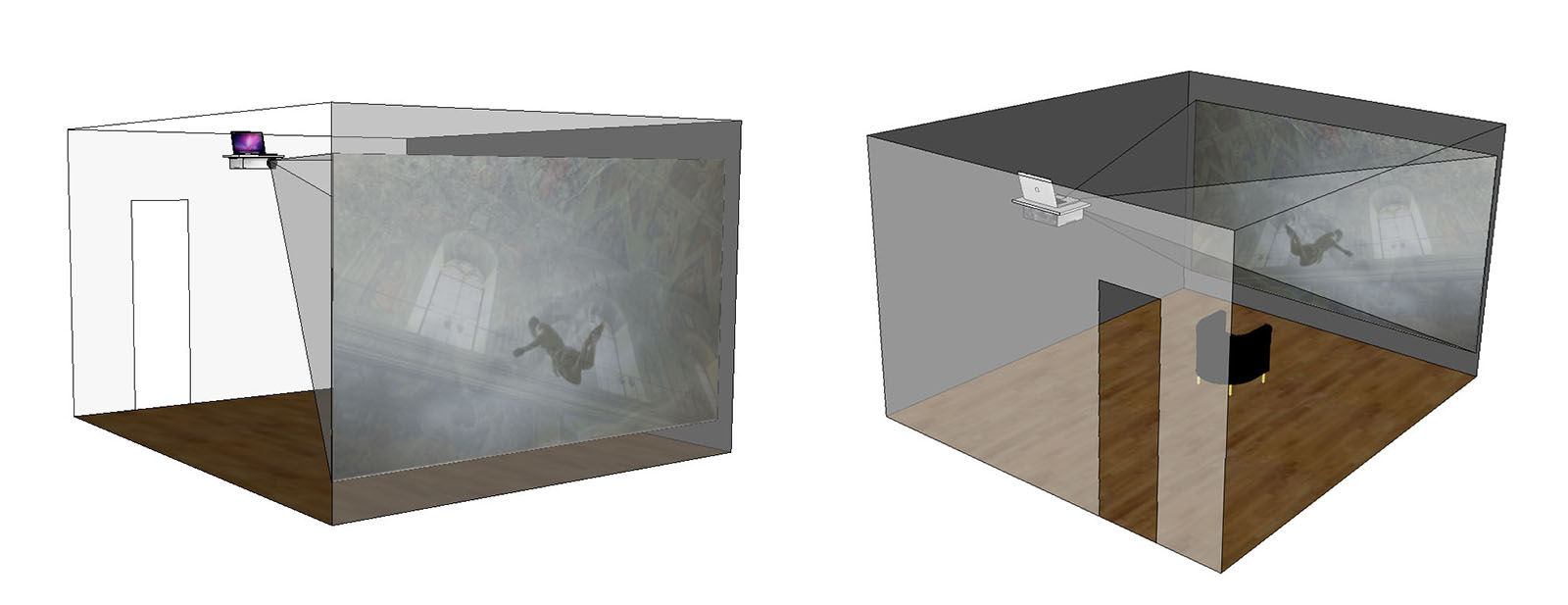
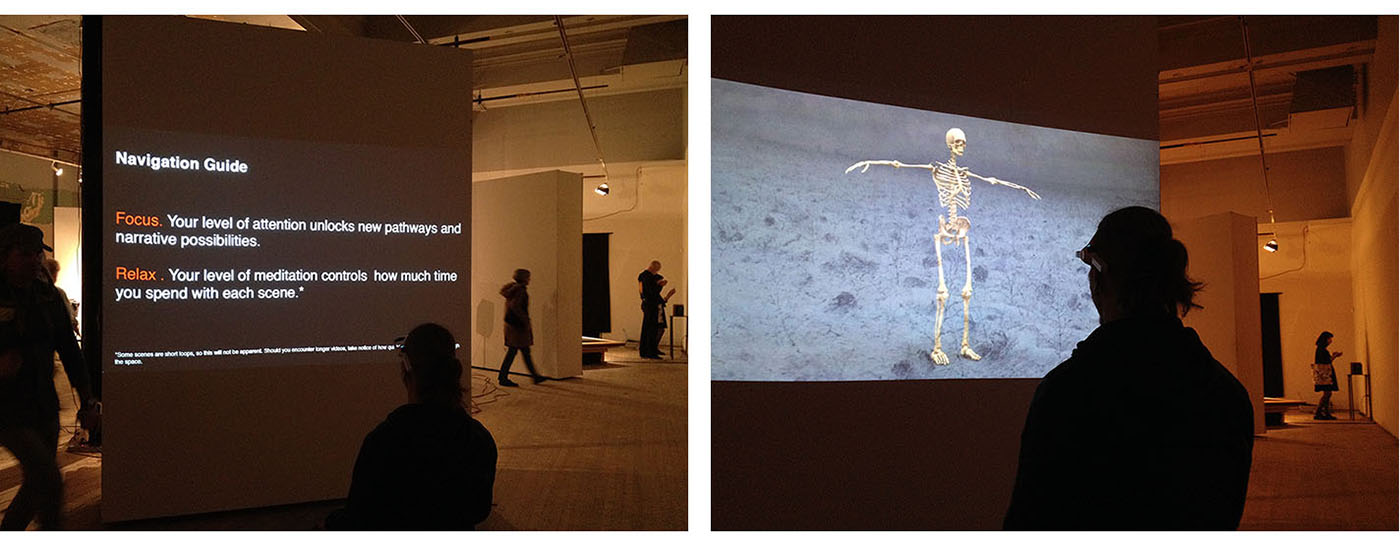
SCOPE
Theoretical Framework: Influenced in part by Walter Benjamin’s philosophy on the concept of history, and his ideas relating catastrophe, media, and memory into what he referred to as the “optical unconscious”, the core of the project focuses on how manifestations of the image in digital, networked media function as a social un-/conscious or living archive through which these apocalyptic visions re-manifest.
Creative Process: I edited thousands of images and videos that I found on the internet to create a database of content. Most of these clips are short loops, ranging in intensity and duration from sharp, staccato, seizure-inducing animated gifs to slow, long takes of mezmerizing scenes.
Custom Software: I created a custom program in MAX/MSP/Jitter that functions like a two-channel video mixer set up to crossfade indefinitely. All of the clips in the database have custom properties and are mapped to one another like an intricate labyrinth.
User Experience: The video mixer is controlled by an EEG brain-computer interface in realtime. As the viewer’s brainwave state shifts in response to the content they are witnessing, they lose or gain access to different parts of the video database, making each “screening” both idiosyncratic and unique.
For more technical details, notes on inspirations, framing questions, theorectical underpinnings, and documentation of my creative process, check out:
Case Study
STILLS / SEQUENCES
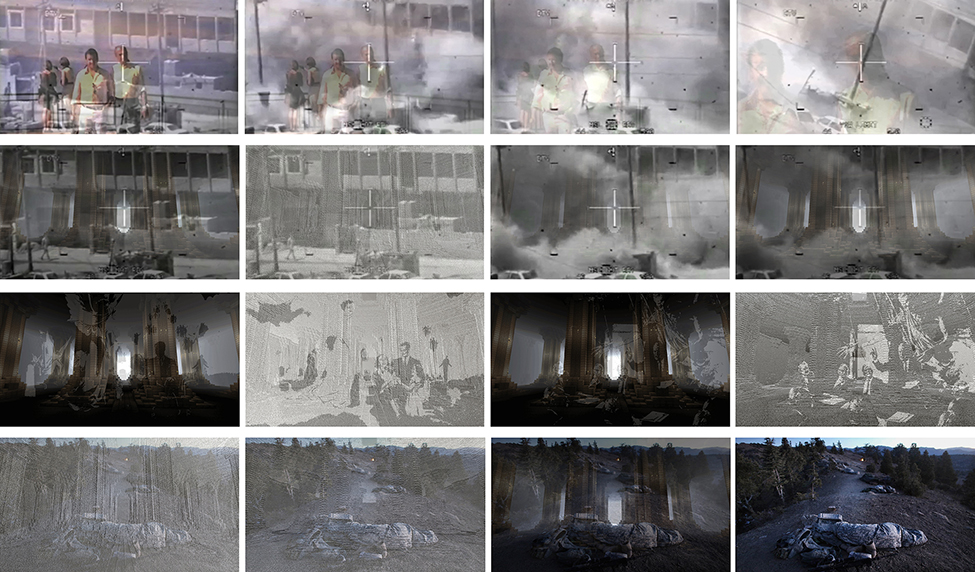
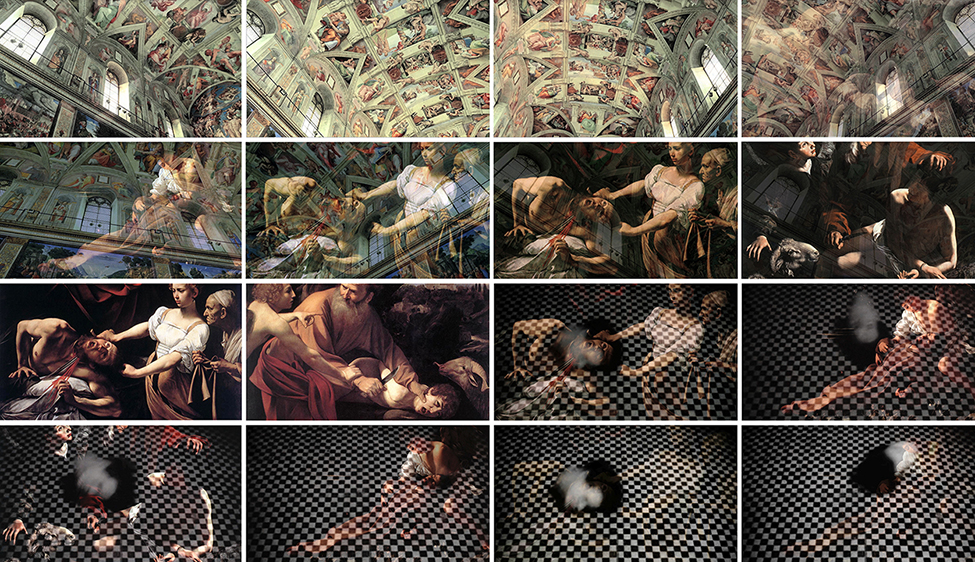
LOOPS

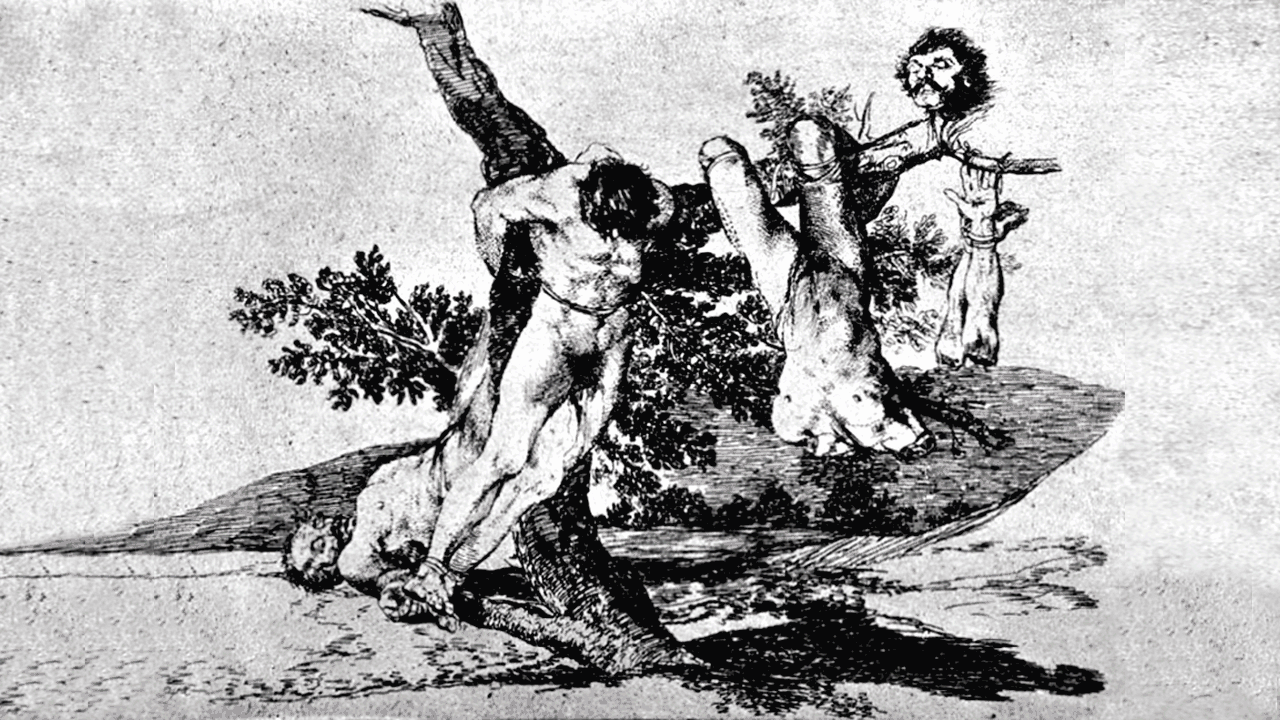
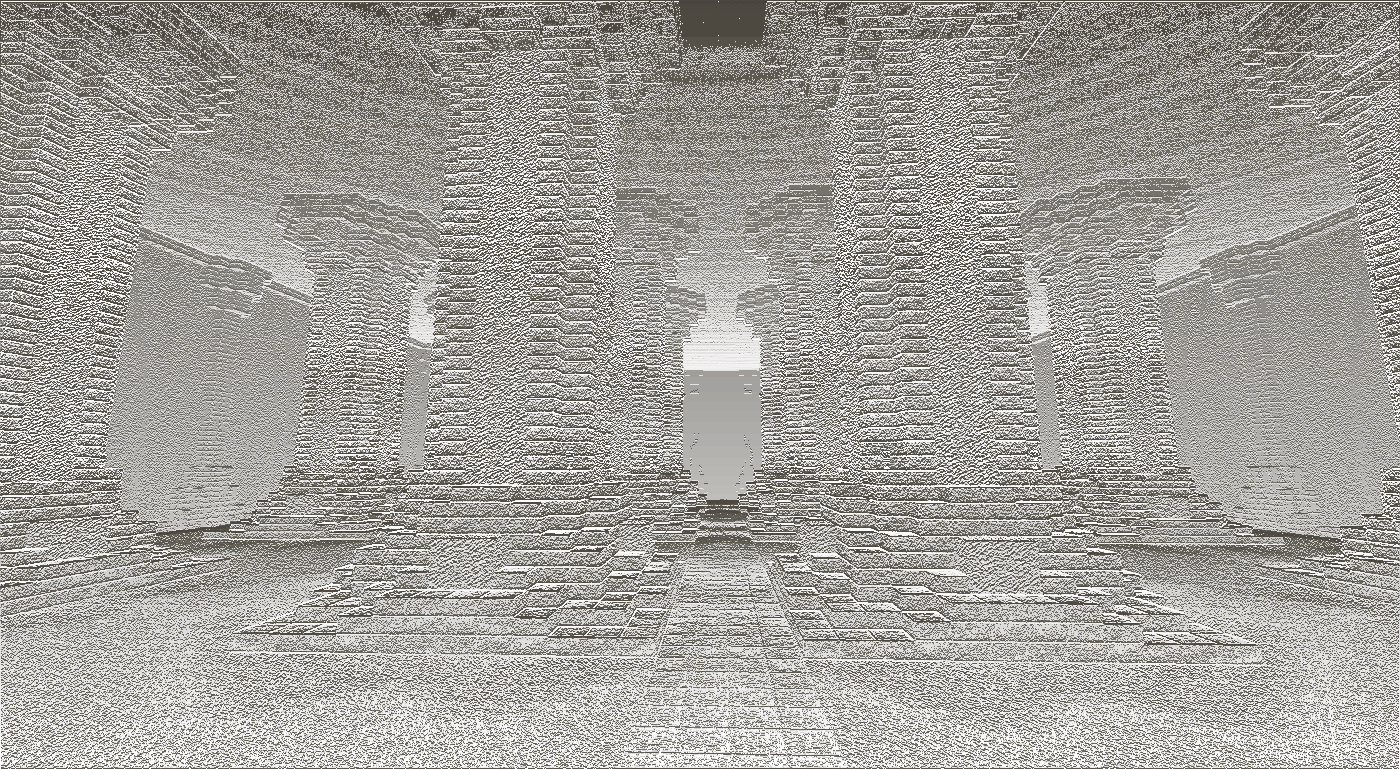

ANTI-APOCALYPSE: ON THE CRISIS OF NOW AND THE FUTURE OF TIME (AN INCOMPLETE MANIFESTO)
-
0. introduction
-
1. intervals: end times (atemporal system (temporal system) )
1. intervals: end times (atemporal system (temporal system) )
"For some time now, our whole European culture has been moving as toward a catastrophe, with a tortured tension that is growing from decade to decade: restlessly, violently, headlong, like a river that wants to reach the end, that no longer reflects, that is afraid to reflect."
– Friedrich Nietzsche, Will to PowerAt times, I feel as if we are living in a psychotic nightmare of theologically determined historical fiction in which the inevitability of death is an error that must be corrected and life is a problem that must be sacrificed, perfected, or controlled for the sake of the former. I am both horrified and fascinated with how these ideas about life and death so strongly persist in and of themselves, but am even more intrigued as to how they function along side a seemingly paradoxical obsession with the apocalyptic visions that arise from within the same cultural and ideological frameworks. I am curious as to how these beliefs function as both a psychic defense against the very real horrors we can’t or don’t want to face and as a compulsion to find meaning in history through the fulfillment of prophecy.
Influenced in part by Walter Benjamin's philosophy on the concept of history, and those relating catastrophe, media, and memory into what he referred to as the “optical unconscious", the core of this project focuses on how manifestations of the image in digital, networked media function as a social un-/conscious or living archive through which these violent, apocalyptic visions re-manifest.
-
1.1 on the nature of anticipation (+ / – )
1.1 on the nature of anticipation (+ / – )
In times of continuity the future equals the past
In times of social-cultural change the future will not be like the past
If we don’t act ourselves, we will be acted upon
Our perception, must be foresight rather than hindsight
- Heinz von Foerster, Understanding Understanding: Essays on Cybernetics and Cognition
1.1 looping backwards to go forward to begin again
If the nature of anticipation is one in which we expect the future to be like the past, is it likely that we are always, partially, moving incrementally towards multiple future-pasts? And if so, does this delay the future-future or is it necessary to re-inscribe the past in order to create new futures? In other words, when does something “new” emerge from this recursive streaming of memory events?
1.2 looping backwards to go forwards to go forward to go forward to the end
Alternatively, does this very system (memory) that allows us to anticipate – to recall, recognize, and thus react to future events, insuring our survival – simultaneously, propel us towards self-annihilation? When taking the long view, does anticipation, which operates in the same temporal dimension co-inhabited by our sense of “progress” – moving forward, accelerating, increasing in disorder or entropy, approaching a limit (exponential) or an end (linear) – propel our imaginations to consider finite and future driven world-ings of inevitable death and destruction? How does something that functions to protect us from immediate danger seem to, at the same time, aid in obscuring our collective evolution? Is this “death instinct” hardwired into our collective genetic inheritance or an idea that we have isolated and overemphasized (via language, culture) for so long that no number of iterations seem capable of shifting something etched so deep into the collective psyche?
-
1.2 (on screen) encounters: aesthetics and the “passive” observer
1.2 (on screen) encounters: aesthetics and the “passive” observer
The Ethical Imperative: Act always so as to increase the number of choices.
The Aesthetical Imperative: If you desire to see, learn how to act.
- Heinz von Foerster, Understanding Understanding: Essays on Cybernetics and Cognition

The rhetoric of post-911 national identity politics, this age of invisible enemies, "kill lists" and drone vision does not fall short in anyway of encouraging a climate of heightened paranoia, fundamentalism, and superstition. The drone: a nameless, self-less, multi-manned, supernatural machine-entity hovering above bodies, for hours, in shifts, uninterrupted, watching everything you do, with your loved ones, your body, your interactions with bodies, your negotiations with the other bodies suspect of being guilty, guilty by association, guilty by association to subversive actions, subversive actions that may or may not be threatening, that may or may not be terrorizing, that a may or may not be linked to the networks of terrorist threat that justifies the need to terrorize and threaten everybody, every body, every waking and non-waking hour and minute and second and nanosecond beyond time, beyond borders, beyond skin, beyond sense, beyond sanity, beyond the beyond.
This endless surveillance, this hyper-vision, is a blurred vision, a muddling of aesthetic and ethical imperatives that are in their infinite repetition and re-inscription, an erasure of the underlying principles that allows a de-politicized subject, in good conscience, a position of non-/ inter-/ action, a means to protect the peace by any means necessary. Of course, this would not be as effective without the not-so-subtle gesture of “national security” narratives enabling the self-granted anonymity of military action in order to justify the sociopathic indifference to those targeted, both intentional or “collateral”, as an unflinching, necessary, moral absolute.
As we move further into this age of increased techno-militarization, I ask: how do aesthetics function in a culture in which military personal spend their workdays engaging with/in an image-world of the “virtual” life and death reality of human beings thousands of miles away? How does a sustained, constant exposure to images that expand the envelope of traumatic thresholds function beyond the screen? How does the witness (the drone pilot) and every iteration of witnessing (the video of the event seen by you and me, the event itself witnessed by the people on the ground) influence our seeing and our ability to influence the realities we bare witness to, both actual and psychological, individual and collective? How many new iterations of witness-witnessings do we create in the fragmented-collective imagination of remote watchers? And in turn, how do all of these eyes and minds influence the relationships between the individuals “in control” and the targeted individuals unaware of a possible immanent fate of which they have little to no control over predicting the time and place of fulfillment, in spite of being haunted by the images of this possible future, everyday, at every level of psychic and corporeal awareness?
-
2. intervals: fractal time (memory events)
2. intervals: fractal time (memory events)
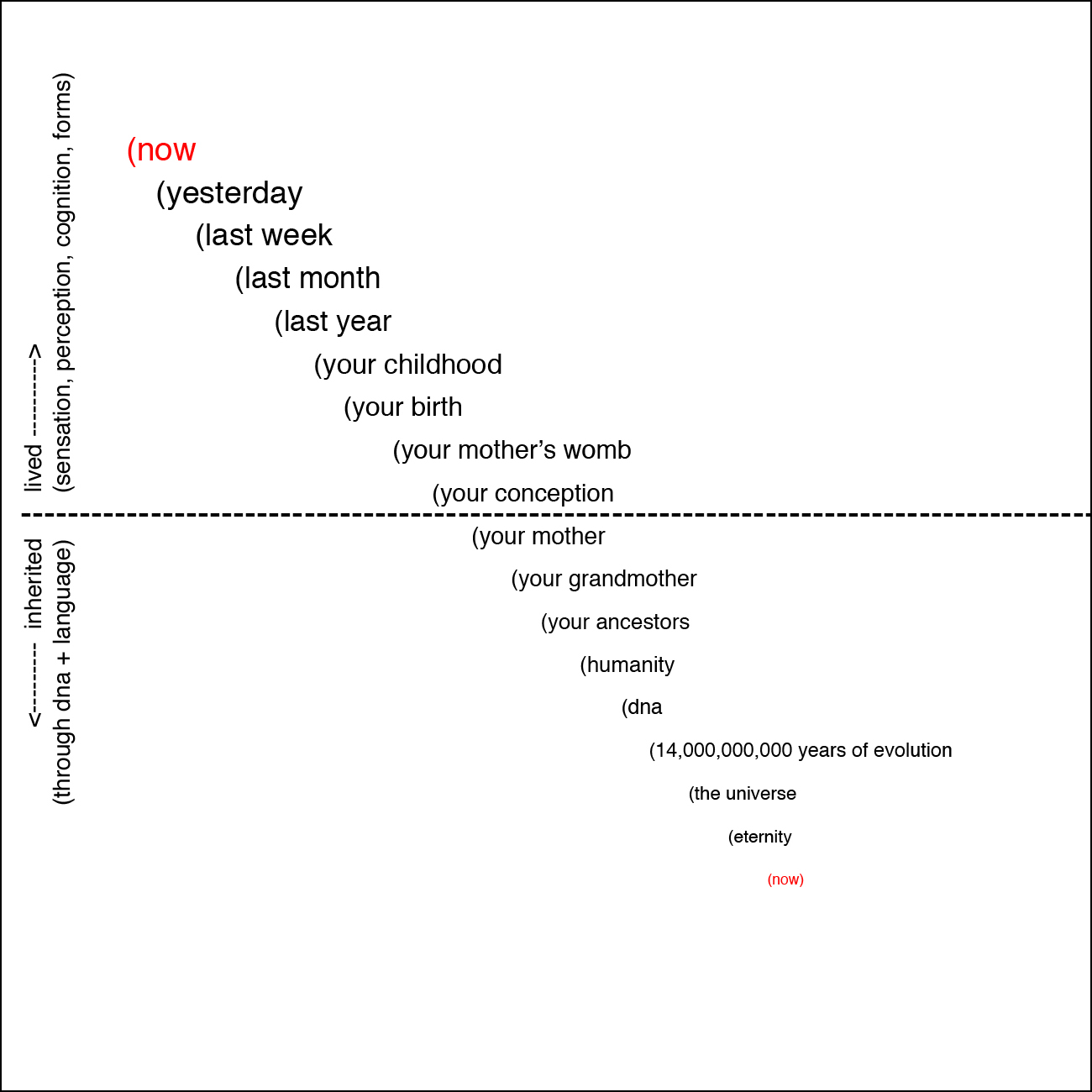
-
2.1 witnessings of shadow and light (eternal return)
2.1 witnessings of shadow and light (eternal return)
In this digital archive of memory that belongs to everyone and no one, has no beginning or end, is "groundless" and temporally un-bound, the act of remembering is amplified as a fractal process of compression/expansion and nested accumulation that exists as an implicit consequence of the unconscious rituals inherent to the nature of our temporal experience. As with the mental world, the rituals of the image-worlds we bring forth are similarly structured: layers of the distant past are nested into layers of the distant present, continuously re-inscribing themselves and intensifying those impressions which have been revisited most over one’s lifetime. Among these impressions are ones that are disregarded, repressed, denied, etc., as well as others that are etched so deep, they reverberate beyond the surface – violently, obsessively, uncontrollably. But these two extremes of consciousness are inextricably linked, one pole always a mask or stand-in for the other, which appears casually inert until it is no longer containable.
Today, our experience of the world as mediated by image or screen-based technologies is not only collectively witnessed, shared and altered on an unprecedented scale, but is profoundly transforming the way people living in networked societies encounter “the world”. The power of collective memory and the relationship between the image and the imagination as manifestations of the “inactive will" surfaces through two very distinct yet inextricably linked networks of image-forms: 1) the mental image, circulating within the psychological depths of the boundless and recursive non-space of memory, and 2) the tangible image, circulating within the information networks and material spaces of their formal incarnations. Distributed widely through digital communication networks, today these images move beyond the territories where they originate, to a dispersed, un-/intended, global audience through which any number of new narratives, uses or manipulations can be applied.
I speculate that as this new networked-reality continues to bring forth an accumulation of visual worlds saturated with acts and images of ultra violence, the role of the observer will become crucial to understanding the emergence of a collective shadow that is at once fully visible and yet still greatly un-reflected upon. This recalibration of self/image will also largely depend upon confronting the apparent disconnect of self-/recognition continuously reinforced through the parsing of our emergent collective experiences into categories of object-identities, a practice/perception that if left unchallenged, will never be reconciled for it is based on interpretations of being that can only be true at the exclusion of any and all other interpretations. These interpretations include, among many things, our projected identities, which Nietzsche argues must be revised for:
Here lies the chief temptation to assume a "soul," which, outside time, reproduces, recognizes, etc. But that which is experienced lives on "in the memory"; I cannot help it if it "comes back," the will is inactive in this case, as in the coming of any thought. Something happens of which I become conscious: now something similar comes – who called it? roused it? 1
This erroneous interpretation of a self-/identity – simultaneously acknowledging the projected self-/image while de-personalizing the literal image and the material body – is persistent today. In spite of centuries of visual mediums re-/producing a collective consciousness traumatized by acts of violence and/or obsessed with macabre and spectacle, there is still an overwhelming conviction that images are representations that exist “out there”, apart from the real world we inhabit and interact with/in. This separation is so ingrained that we readily default into the habitual classification systems that order certain types of images into categories of fiction (e.g. fantasy, illusion) in order to distinguish them from facts, experience, or “real life” – as if those distinctions alone could account for the underlying, un-nameable compulsions to create and consume more of whatever these so-called fictional representations call forth.
In the case of factual representations of violence (e.g. photographic evidence or documentation), the disassociation between the seer and what has been seen is largely based on the presumption that the power relations inherent to this exchange are unidirectional and in which the observer, being “passive”, plays no significant role. Psychologically, this non-role serves to simultaneously exonerate and disempower the observer, whose spatial-temporal non-position in the causal chain of the actual events removes any involvement (i.e. direct implication) of the remote witness consciousness by placing them outside of time and therefore reinforcing the idea that what exists beyond the surface of the image is both unalterable (because you can’t change the past) and permeable only in so far as it extends the number of victims to include them and every witness to that image-event. In other words, the unidirectional paradigm of spectatorship can only re-/produce consumers or hostages, if anything at all.
As the notion of this misconstrued passivity persists, the role of the observer is implicated more as one of an unwitting, complicit participant, ignorant of the latent forces of an inactive will that has and will always inevitably surface in response to what has been experienced (i.e. perceived by the senses), which includes all of the responses the “rational” self hides from consciousness. The problem with passive observation then, is not inherent to the act of seeing itself, which requires one to be receptive, not passive, but with the lack of critical reflection on the effects of what has been seen, remembered, recalled and reenacted. This lack of reflection includes filtering what is seen from consciously registering beyond what is conditioned to structure reality into a “schematism of ‘things’.” 2 And so, the observer of things, always looking out at the world, never inward, is denied an active presence within their experience of witnessing, which for better or worse, “protects” them from anything that threatens to collapse the perceptual boundaries between inner/outer worlds, keeping them from confronting any number of “irrational” re-/actions or ruptures.
In any case, whether those un-/realized effects are ones that normalize and aestheticize the witnessing of endless acts of violence or ones in which the violence is overwhelming, the levels of un-/conscious awareness between them are both subtle and profound – their unraveling, an even more elusive process that requires the most extreme and external of these psychic traces to be brought to the most intimate proximity and consideration. As Nietzsche proposes:
Consciousness – beginning quite externally, as coordination and becoming conscious of ‘impressions’ – at first at the furthest distance from the biological center of the individual; but a process that deepens and intensifies itself, and continually draws nearer to that center.” 3
These unwilled recurrences would continue re-manifesting as long as “impressions” (i.e. the substrate of memory, “projected causes”) remained both unrealized and unarticulated. Transforming the re-surfacing memory-events from an “inner world” requires one to not only redirect the witnessing inward, but it requires a language or medium with which to process the shock of re-/integration between inner and outer worlds. Without a language to facilitate this shift in being-awareness, understanding anything becomes impossible for, "’to understand’ means merely: to be able to express something new in the language of something old and familiar.” 4
So – if we, as observers, allow such dispassionate adaptations or delusions about the mediated image-worlds we co-author to evolve without radically transforming the depth at which we experience and self-reflect on their implications, how are we to see a future that is not interlaced with layers of traumas from the past, continuously reemerging as records or acts of violence re-inscribed in the present? As this shadow side draws nearer to center, how will this acute presence with/in darkness transform our seeing?
1 Nietzsche, The Will to Power, 502 (1885)
2 Nietzsche, Will, 479 (Jan-Fall 1888)
3 Nietzsche, Will, 504 (1883-1888)
4 Nietzsche, Will, 479 (Jan-Fall 1888)
-
2.2 digital (in)coherence: baroque re-visions
2.2 digital (in)coherence: baroque re-visions
“What about the ground realities of life and death, in a world that has instituted the shape-shifting potential of the virtual as its dominant order?” 1
“The Baroque solution is the following: we shall multiply principles – we can always slip a new one out from under our cuffs – and in this way we will change their use.” 2
The dilemma set forth by 2nd order cybernetics comes from the realization that the transformational shift to a machine-networked society would yield and give access to “infinite” information, enabling all theories to be substantiated, thus making all substantiated theories true. 3 On one hand, what this alludes to is that “truth does not make sense; it exceeds meaning and exceeds measure. It exceeds all regimens of truth… The anthropologist, remember, does not find things; s/he makes them. And makes them up.” 4 Of course, this is not literally true; it is a problem with the language of logic (or the logic of language) closing in on itself, the black box. The subtext, on the other hand, is where the truth lies; making up “true” stories is easy, the hard part is parsing out the ones that are actually happening, for real.
In this age of global networks, global consciousness and global terror, the accelerating, perpetual loss of the “ground” of reality is no longer just a concern for cybernetic theory, postmodern skepticism or nihilism in its extreme form (i.e. grasping for a theory of absolute nothing-ness to replace the rejection/loss of absolute something-ness). Instead it is an all pervasive, all inclusive collapse – a form of nihilism Baudrillard describes as: “one of transparency and […] in some sense [one] more radical, more crucial than in its prior and historical forms, because this transparency, this irresolution is indissolubly that of the system, and that of all the theory that still pretends to analyze it.” 5
Today’s crisis is that every (ontological) system is being disrupted continuously, indefinitely, clashing in an “[…] excess of principles, a hubris of principles, and a hubris inherent to principles”. i As the once clear, distinct narratives used to cohere collective identities lose their center and frames of reference, new narratives made up of their remnants emerge to take their place; while the old narratives, hollowed out, continue anyway, regardless of whether or not they can substantiate their claims. It is as if the structure of the story and the promise of a deliverance are the only ingredients necessary to sustain the façade: no logic, no substance, no sense required– literally, a total rejection of the affective body.
Deleuze writes of the advent of the Baroque as an inevitable consequence of a similarly destabilizing crisis of such magnitude and depth occurring within the dominant theological systems of the time:
A psychotic episode had to take place. A crisis and collapse […] had to take place. That is where the Baroque assumes its position: Is there some way of saving the theological ideal at a moment when it is being contested on all sides, and when the world cannot stop accumulating its ‘proofs’ against it, ravages and miseries, at a time when the earth will soon shake and tremble…? 6
Today, it is within such chaotic unravelings that the politics of fear and the promise of an Apocalypse returns.
[incomplete]
1 Holmes, Brian, “Filming the World Laboratory”, online essay.
2 Deleuze, The Fold: Leibniz and the Baroque, 76.
3 Dammbeck, Lutz, Das Netz. DVD, interview with Heinz von Forester, 2003.
4 Minh-Ha, Trinh, “Grandma’s Story”, Woman, Native, Other, 35.
5 Baudrillard, Jean, Simulacra and Simulation, 159.
6 Deleuze observes this of the Baroque: “[A] time just before the world loses its principles. It is the splendid moment when Some Thing is kept rather than nothing, and where response to the world’s misery is made through an excess of principles, a hubris of principles, and a hubris inherent to principles.” Deleuze, The Fold, 77.
7 Deleuze, The Fold, 76. -
2.3 digital event time
2.3 digital event time
The pace of fracture is one of jittery agitation and jungle speed bpm. These digital video loops are but utterances, spliced together, chopped up, sped up, and remixed into a dizzying montage of serialized events and “special occasions” that become stripped of their unique qualities as the quantity of images and cycles of repetition increase. The emerging perceptual phenomenon lets us recognize in these schizo-homogenous assemblages a trace of something that was once me and you, idiosyncratic, charged with meaning, sentimentality. And yet, this me, this you – this I – is nested in a process of accumulation that absorbs those details into a cloud so forgettable, so banal, it seems almost contradictory that both can be appearing to us simultaneously. What becomes significant then is not so much in the details, as it is in the speed and relationship between receptivity and recollection.
Trinh T. Minh-Ha notes the nature of the digital image is that “rather than working with an event, in which form in their material support (the celluloid) emerges progressively, one faces here an event of accelerated disappearance.” 1 This disappearance invites one to experience an unnamable dimension of time that presents a paradox in which the idea of the representational subject, whose actual memory functions by situating one in past and present, spatial and material, mental and emotional worlds simultaneously, begins to fall apart on the non-simultaneous premise from which the very idea of the subject emerges. The problem here is both with the concept of the subject as an indivisible self and with the chronological model of progressive, linear time contradicting the experience of being in time. This interpretation of temporal experience presents a second paradox for Deleuze who suggests that, “time must be grasped twice… [for] only the present exists in time and gathers together or absorbs the past and future. But only the past and the future inhere in time and divide each present infinitely. These are not three successive dimensions, but two simultaneous readings of time.” 2
Of course, this both/and moment is short lived, for as Deleuze goes on to suggest, "this event is, of course, quickly covered over by everyday banality or, on the contrary, by the sufferings of madness." 3 By this, he means that by its very nature, the double-structure of the event will either lead to the usual perceptual habits and repetitive actions or a decent into the chaos of irreconcilable selves/worlds. In other words, to identify as oneself (myself) means that the world will always appear as separate/other; to not identify as oneself (not-myself) and to have no means with which to evoke a reconciliatory position between one-self and non-self, then it would inevitably follow that the either/or structure of a temporally bound subject identity will either persist as a matter of convenience and self-preservation or collapse as a matter of what Nietzsche calls “great suffering”. 4
In the datascape of the digital, this tension between the disappearance of reality and an excess of reality is present as both a philosophical paradox and as a lived experience made explicitly more apparent by the multiplicity of effects the ever-increasing speed of technology’s rhythms has on how we perceive and process our experiences within the new networked-reality.
1 Deleuze, The Fold, 17.
2 Deleuze, The Logic of Sense, 5
3 Ibid., 249.
4 Nietzsche, Beyond Good and Evil, 225.
-
3 intervals: now time ( )
3 intervals: now time ( )
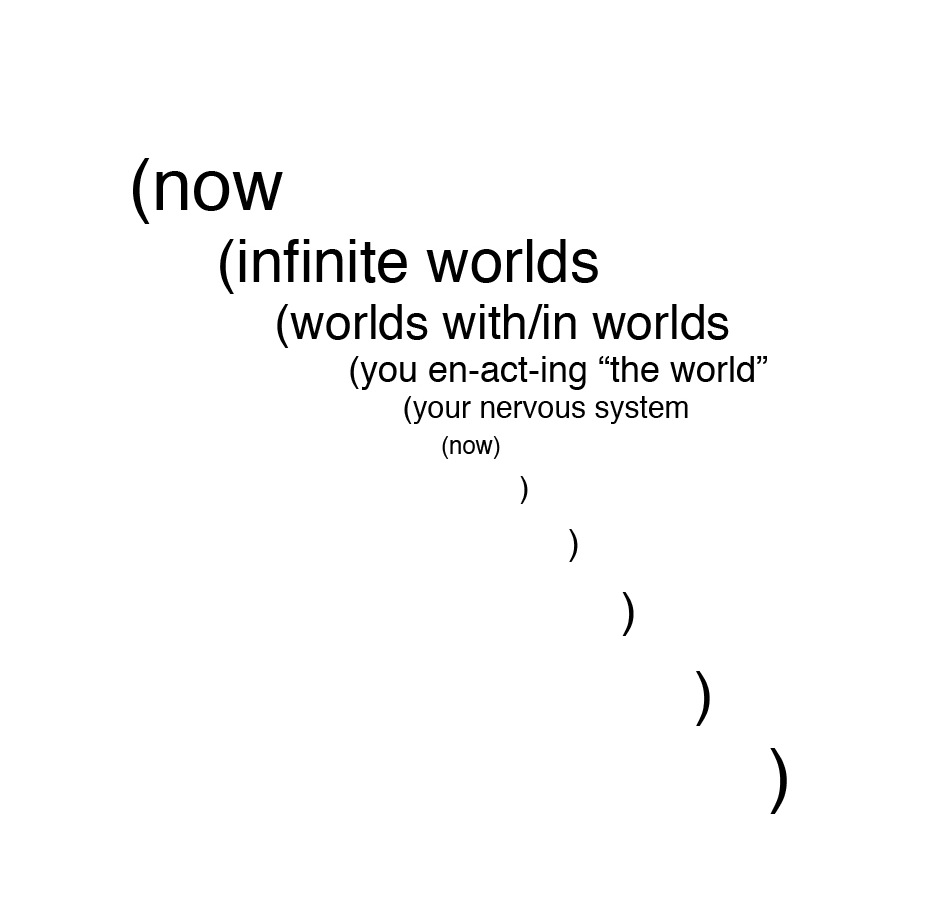
-
3.1 digital event horizon: an art of the body questioning itself through itself
3.1 digital event horizon: an art of the body questioning itself through itself
Psychology has a good deal to say about the living relationship with the brain, of a lived body, but it has less to say about a lived brain. Our lived relationship with the brain becomes increasingly fragile, less and less 'Euclidean' and goes through little cerebral deaths. The brain becomes our problem or our illness, our passion, rather than our mastery, our solution or decision. 1
Francisco Varela reminds us that cognitive science has increasingly asserted that human cognition has no “ultimate foundation” or “ground”; echoing Nietzsche’s predicament that “our historical position – and no end to it is in sight – is that of having to philosophize without ‘foundations’.” 2 And yet, he observes that in spite of this realization being made multiple times 3, neither Western philosophy nor Western science has offered much in the way of a new model or practice by which we can come to integrate this theoretical understanding of mind with our everyday lived experience. That is, he observes that this lack of "a methodological basis for a middle way between the objective and the subjective (both forms of absolutism)” 4 is precisely what leads to the fragmentation of the self and the contradictions that arise from the assertion of an either/or position grasping for continuity. The inability to reconcile the notion of a pregiven world with the subjective appearance from which it cannot exist independent of, is what turns the self into both an objectified subject and a subjectified object 5 and what allows “mind-independent objects to be continually challenged [while] object-independent minds never are.” 6
In trying to define and understand the basis of mind/consciousness, cognitive science is still caught in a debate between an abstract-computational model of mind (syntaxical, information-processing based) of vs. an embodied-dynamical model (experiential, dynamical systems based). 7 At the same time, practical psychology observes that things learned in the symbolic and iconic modes of experience– language and visual models, respectively– cannot be transferred to an enactive mode, or direct action. However, knowledge acquired in an enactive mode can transfer to all modes 8 – an assertion that reminds us that knowledge and experience are fundamentally linked; moreover, that understanding anything is situated first and foremost in the knowledge-experience of the body, which brings forth its wisdom through the inextricable processes of what it perceives, re-views, and enacts. In explaining how these processes give rise to our realities, Varela specifies that enaction implies that “sensori-motor coupling modulates, but does not determine an ongoing endogenous activity that it configures into meaningful world items in an unceasing flow.” (my emphasis)
In trying to understand our autonomy as something that arises through a configuration of these processes, I think it is important to note that to act, then, is to engage your entire nervous system, something so idiosyncratic to you that it makes little sense to frame the question of agency by defaulting exclusively to the relations of power relations, which usually infer that, 1) we are predominantly being acted upon by outside forces, 2) any given set of choices are usually bound to the conditions dictated by those forces (laws, god, invisible economies), 3) we occupy separate, quantifiable positions in this exchange, and 4) our options are then implicitly: a negotiation of impositions that must be agreed upon by whoever is in charge of imposing those impositions on the rule of order. That is not to say these forces are not real or irrelevant – to the contrary, it is to affirm that within the dominant social, cultural, and geo-political orders, the individual’s experience (i.e. degree of awareness of the interplay of those forces) plays a significant role in determining their effects.
[incomplete]
1 Deleuze, Cinema 2, 212.
2 Varela, The Embodied Mind, 218.
3 In The Embodied Mind, Varela cites Nietzsche, Heidegger, Vatimmo’s “weak thought” in post-structuralism and postmodern thought (e.g. Lyotard, The Postmodern Condition; Vattimo, The End of Modernity; Derrida, Of Grammatology, Derrida, Margins of Philosophy; Foucault, The Order of Things; Foucault, Discipline and Punish) (Varela 229)
4 Ibid., 230.
5 Ibid., 242.
6 Ibid., 233.
7 Ibid., 116.
8 van Dijk, Jan. The Network Society, 220.
-
3.2 if body, then choice
3.2 if body, then choice
